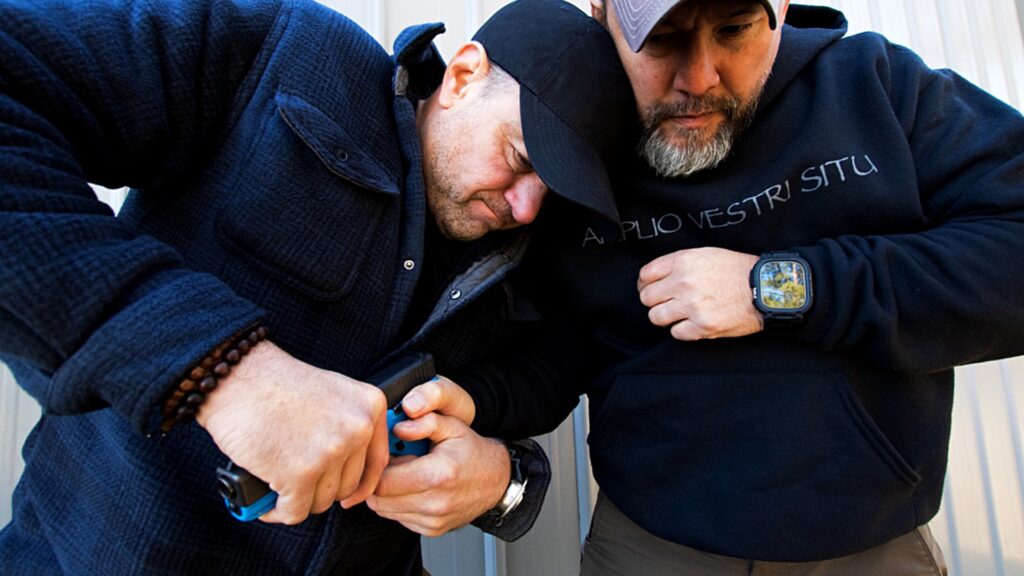
In the expansive realm of self-defense training, two disciplines consistently capture the spotlight: firearms training and combatives. Enthusiasts frequently dedicate their weekends to mastering these skills, often focusing on refining their shooting accuracy and techniques one weekend, then switching to enhance their prowess in unarmed combat during the next. However, there is a growing acknowledgment among practitioners and experts alike about the importance of integrating these two areas.
This integration is crucial because real-world self-defense scenarios often require a seamless transition between armed and unarmed tactics. The ability to switch effectively from handling a firearm to engaging in hand-to-hand combat or the skill of close-quarter firearm manipulation can be the difference between safety and peril. Therefore, a holistic approach that bridges the gap between firearms training and combatives not only broadens one’s skill set but also enhances the practical applicability of these techniques in actual defensive situations. This convergence of skills prepares individuals not just in technique but in the tactical application of these techniques under stress, fostering a more comprehensive defense strategy.
Historically, combatives and firearms training have run on parallel tracks. This separation might seem logical given the distinctive skills and tactics each domain requires. However, close protection or real-world situations rarely offer the luxury of a clear distinction between situations best addressed with empty-hand techniques versus those that necessitate firearm use.
The growing demand for integrated defensive tactics has pushed experts in combat science and defensive tactics training back to the drawing board and back into the laboratory, leading to the birth of what I often call a “Gap art.” This innovative approach has sparked the development of new curriculums, resulting in the emergence of highly effective materials and techniques. These advancements are reshaping the landscape of self-defense training, offering practitioners more cohesive and versatile methods to protect themselves in various scenarios.
Why Integration Matters: The Fluidity of Threat
Violent encounters are inherently unpredictable and often volatile, devoid of any predictable pattern or script. An assailant’s actions are erratic, and confrontations can erupt swiftly and without warning. For instance, consider the shock and disorientation of being sucker-punched or suddenly ambushed. In these critical moments, the initial instinct might not be to draw a firearm, even if one is readily concealed on your person.
In such high-tension situations, it’s crucial not just to rely on the ability to use a firearm. Instead, The immediate need might be to employ robust combative skills to neutralize the immediate threat effectively. This concept is vital to defend oneself or one’s principal without escalating the situation through the use of firearms and to ensure that the firearm does not become an additional liability. If an assailant gains control of it, the situation could worsen dramatically.
Therefore, integrating firearm training with unarmed combat skills is paramount. This combined approach allows individuals to fluidly switch between using a weapon and applying physical defense tactics as the situation demands. Training to transition between these modes of defense seamlessly equips individuals with the versatility needed to respond effectively to any threat level.
This integration of skills can dramatically increase one’s safety during an assault by providing multiple response options. By preparing for various scenarios, from de-escalation to physical engagement, individuals can maintain control over the situation, protect themselves effectively, and secure their weapon against misuse by the assailant.
The Challenge of Protecting Your EDC
An everyday carry (EDC) encompasses the essential items you carry on the job daily, particularly your concealed firearm or edged weapon. While a concealed firearm can provide a significant security advantage, integrating this into a self-defense strategy presents unique challenges. Traditional martial arts, effective as they may be in unarmed scenarios, often do not address the complexities of managing a concealed weapon during an altercation. This oversight can lead to the firearm becoming exposed or accessible to an assailant during physical confrontations, potentially escalating the danger to both you and. your client.
To counter these risks, it’s crucial to adapt and evolve standard martial arts techniques to accommodate the presence of a firearm. This approach means using defensive maneuvers to protect yourself from an attacker and consciously working to shield and retain control over your firearm. Ensuring that your EDC items, especially a firearm, remain secure and inaccessible to the attacker must be a priority throughout the encounter.
Adapting martial arts techniques to incorporate EDC considerations requires a significant shift in methodology.
Practitioners must develop skills that allow them to manage and retain their weapons effectively while engaging in close combat. This dual focus on defense and weapon retention creates a hybrid self-defense system that is more aligned with the realities of facing armed or particularly aggressive assailants.
Such adjustments lead to the development of a new set of defensive tactics that are specifically designed for those who carry concealed weapons. This approach extends beyond traditional training and into a specialized field that addresses the strategic use of the body to protect both oneself and one’s equipment. By incorporating these principles, you enhance your ability to control the outcome of a threatening situation, ensuring both personal safety and the security of your everyday carry items.
The Close-Quarter Reality
The harsh reality is that many violent confrontations occur within the intimate range of 0 to 5 feet, a distance that drastically complicates decision-making processes. In such close quarters, the choice isn’t simple: Should you immediately draw your weapon or engage in hand-to-hand combat to create a safer opportunity to deploy your firearm? This dilemma is a critical challenge many face, requiring split-second judgments that can significantly impact outcomes.
Our aim in our self-defense training is not merely to teach firearm usage or combative techniques as separate disciplines but to integrate these skills comprehensively. This integration ensures that individuals can smoothly transition from unarmed to armed tactics, adapting to the demands of the situation with agility and precision. Such a holistic approach is vital as confrontations are dynamic, and the appropriate response might rapidly shift from verbal de-escalation to physical defense and potentially to the use of a firearm.
As protection-focused self-defense continues to evolve, so must our training methodologies. Our training must stay at the cutting edge, challenging conventional paradigms and fostering a unified approach to personal security. This need means pushing beyond traditional training frameworks to emphasize the necessity of a cohesive strategy that seamlessly combines various defensive tactics.
Training in the “Range” of Verbal Confrontation
The term “range” in combat often refers to the distance between opponents. However, in the context of the social buildup to physical engagement, “range” can be understood as the spectrum of interactions that precede actual combat. This includes verbal sparring, attempts at intimidation, and the dance of body language that can either lead to or prevent a physical altercation.
In close protection and self-defense, while the physical altercation often grabs headlines, the precursor interactions are equally, if not more, critical. Before any punch is thrown or weapon drawn, a subtle yet significant exchange of words and body language unfolds. This phase, though frequently underestimated, is crucial to the outcome of the encounter.
Conflicts don’t typically erupt into violence spontaneously; there is often a gradual buildup characterized by verbal sparring, physical posturing, and subtle cues. This preliminary period is a critical time to assess, assert, and defuse the escalating tension. Managing this phase effectively is about balancing assertiveness and careful assessment.
This preparatory interaction can be likened to a strategic game of chess, where each verbal and non-verbal cue can significantly influence the direction of the encounter. Every spoken word, gesture, and even tone of voice can either escalate or help de-escalate the tension. Mastering the dynamics of this early conflict phase is as essential as perfecting physical defense techniques.
This is addressed through the “Sidewalk Drill,” which allows students to enhance their “gift of gab”—effectively navigating these tense exchanges. While some may already be familiar with this interaction through personal experiences or previous training, others may find this new and challenging. The “Sidewalk Drill” provides a structured environment for those unfamiliar with these dynamics to practice and grow more adept at handling such situations, ensuring they can manage these crucial moments confidently and skillfully. This aspect of training is often overlooked in the defensive tactics industry. Just as law enforcement professionals are equipped with specific verbal strategies for de-escalation and control, individuals in close protection roles also require specialized verbal tools. These tools are essential for managing potentially volatile situations without escalating to physical confrontation.
Training in verbal de-escalation and communication is not just an added bonus—it’s a critical component of a comprehensive defense strategy. It must be rigorously practiced in advance, much like physical techniques, to ensure it can be effectively employed under stress. The ability to use one’s voice effectively to command, negotiate, or calm a situation can often prevent the need for physical intervention.
For close protection specialists, having these verbal skills is particularly important. They often operate in environments where discretion is paramount, and the ability to manage conflicts quietly and efficiently without drawing unnecessary attention is invaluable. Therefore, integrating verbal tactics into regular training regimens ensures that these professionals are not only physically prepared but also equipped with a holistic set of skills to handle a wide range of security challenges. This preparation enhances their versatility and effectiveness, making them more adept at protecting their clients under various circumstances.
A well-negotiated verbal exchange can diffuse a volatile situation, rendering physical engagement unnecessary. Additionally, mastering this range instills confidence in individuals, ensuring they don’t inadvertently escalate situations due to nervousness or lack of awareness.
Legal Implications
Beyond the immediate threat, protection specialists must always be mindful of the legal ramifications of their actions. Engaging in self-defense or Client-Defense has its legal intricacies. Depending on the jurisdiction, the techniques and levels of force employed can have varying legal consequences.
Even if it’s an empty-hand technique, every physical move carries potential legal implications. Sometimes, the law might influence the techniques one opts for at different stages of the confrontation. Hence, understanding the legal landscape is paramount. This knowledge ensures that one’s response not only neutralizes the threat but also remains within the bounds of the law.
When I teach, I often emphasize the importance of considering how our actions in security and defense not only achieve their primary goal but also how they are perceived externally. It’s crucial that our techniques and responses appear visually appropriate, socially acceptable, and legally justifiable. This isn’t just a matter of ethical training; it’s a fundamental aspect of operational effectiveness in the protection industry.
We must think beyond the mere functionality of a technique. The visual appropriateness of our actions ensures that they do not cause unnecessary alarm or misunderstanding among bystanders or the media. Social acceptability is also vital, as it maintains public trust and confidence in security operations, ensuring that the community views our actions as reasonable and measured. Furthermore, everything we do must be legally defensible. In the heat of a moment, our actions must withstand legal scrutiny, emphasizing the need for comprehensive training that ingrains these considerations deeply in every protector’s decision-making process.
This holistic approach to training curriculum design in the protection industry necessitates a careful selection of techniques and principles. By using visual appropriateness, social acceptability, and legal explicability as guiding principles, we can significantly influence the techniques and strategies we choose to incorporate. This approach molds more effective and professional protectors and ensures that their methods align with broader societal values and legal standards.
Thus, when designing training programs, it’s essential to integrate these considerations from the ground up. Doing so helps protectors effectively manage physical threats and equips them to handle the perceptual and ethical dimensions of their actions. This comprehensive preparation ensures that they are capable of physical security and adept at navigating the complex social and legal landscapes they operate within.
Physical combat is but one facet of confrontation. The dance that precedes it, laden with social nuances and legal considerations, is equally significant. By acknowledging and training in this holistic spectrum of conflict, one can navigate confrontations more effectively, ensuring safety, legal compliance, and, when possible, peaceful resolutions.
Conclusion
There’s a critical need for a unified approach that bridges combatives with firearms training in the realm of self-defense training. This integration is essential because real-world defense scenarios often demand fluid transitions between unarmed and armed tactics. Practical self-defense isn’t just about mastering individual skills in isolation and seamlessly combining them to adapt to any situation.
Historically, the training for combatives and firearms has been compartmentalized, which might seem logical due to the distinct nature of the skills each requires. However, the reality of close protection and real-world situations need to separate these skills neatly. Instead, it often requires a holistic approach where deciding to transition from hand-to-hand combat to firearms can be critical.
The increasing complexity of threats requires adaptive strategies that merge physical combat skills with strategic firearm use. This calls for innovative training programs that push beyond traditional methods, fostering a blended skill set that prepares individuals both technically and tactically.
Training curriculums must reflect the integration of these disciplines. This approach enhances practical engagement and prepares individuals to handle high-pressure situations with competence and confidence. Training should focus on developing the ability to make rapid decisions, such as determining when it’s safer to subdue an attacker physically or when it’s necessary to escalate to using a firearm.
Moreover, as self-defense tactics advance, so must our educational methods. We’re tasked with developing programs that equip individuals with a comprehensive defense strategy—programs that understand and simulate the unpredictable nature of threats. We aim to provide a training foundation that reflects real-world conditions, ensuring readiness and adaptability in any scenario.
By fostering a unified training approach, we’re not just preparing individuals to respond to threats effectively—we’re shaping a resilient mindset that understands the fluid dynamics of real-world confrontations. This comprehensive preparedness will define the next generation of defense training, making individuals not only capable defenders but also wise and strategic protectors in their environments.

Alan Baker is renowned for his dual expertise in crafting tailored Defensive Tactics Programs and high-performance coaching. Catering specifically to law enforcement agencies, military organizations, and security firms, Alan designs training regimens that emphasize practical techniques, real-world adaptability, and scenario-based training. His approach enhances the capabilities and readiness of personnel in intense situations. Explore Alan’s tailored programs here.
Beyond mere tactics, Alan stands out as the paramount “mindset” coach, adept at unlocking the vast potential within individuals. With a deep passion for mentoring professionals, entrepreneurs, and those on personal growth odysseys, he focuses on nurturing a mindset of excellence. Alan’s coaching hinges on practical strategies that bolster mental resilience, focus, and drive. Teaming up with Alan means embarking on a transformative path where mental barriers are dismantled, inherent strengths come to the fore, and your goals become within clear sight. His profound insights enhance performance and sculpt a mindset tailored for triumphant success.
To delve deeper into Alan’s mindset philosophy, peruse his enlightening collection of books And if you’re ready to amplify your journey under Alan’s tutelage, connect through his official website.

